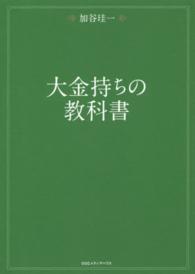- ホーム
- > 洋書
- > ドイツ書
- > Humanities, Arts & Music
- > Music
- > musical equipment
Description
(Text)
Nachdem Schumanns erster Versuch, sich mit der Gattung "Sonate" auseinanderzusetzen, offenbar misslungen war - nur den Kopfsatz ließ er unter dem Titel "Allegro in h-moll" erscheinen - nahm er im Jahr 1833 einen neuen Anlauf. Es ist bekannt, dass diese Sonate in engem Austausch mit der damals dreizehnjährigen Clara Wieck entstand. Einzelne Motive daraus finden sich später in Claras Werk wieder; in der Sonate finden sich umgekehrt aber auch einzelne Figuren, die auf Claras "Pièces caractéristiques" op. 5 hinweisen. Für den zweiten Satz verwendete Schumann außerdem eine fast wörtliche Klavierübertragung seines Lieds "An Anna". Wir drucken es als Beigabe im Anhang unserer Ausgabe und machen damit die Voraussetzungen der Komposition sichtbar._
(Table of content)
Klaviersonate fis-moll op. 11
(Text)
Following Schumann's fi rst, evidently unsuccessful attempt at composing a "Sonata" - he only had the opening movement published under the title "Allegro in b minor" - he tried once again in 1833.
It is a well-known fact that this sonata was composed while he was in close contact with Clara Wieck, who was thirteen at the time. Individual motifs from it can be found later in Clara's work; but by the same token, individual figures can be found in the sonata which point to Clara's "Pièces caractéristiques" op. 5. In addition Schumann used an almost literal adaptation of his song "To Anna" for the second movement. We have included this in the appendix of our edition and in so doing show the roots of this composition._
(Table of content)
Piano Sonata f sharp minor op. 11
La première tentative de Schumann pour s'attaquer au genre de la «sonate» ayant apparemment échoué - il fait paraître le 1er mouvement seulement sous le titre «Allegro en si mineur» -, il prend en 1833 un nouveau départ. On sait que cette sonate a été écrite en coopération étroite avec Clara Wieck, alors âgée de treize ans. On retrouvera plus tard divers motifs dans l'oeuvre de Clara; à l'inverse on trouve aussi dans cette sonate plusieurs fi gures renvoyant aux «Pièces caractéristiques» op. 5 de Clara. Schumann utilise d'autre part pour le deuxième mouvement une transcription pour piano quasi textuelle de son lied «An Anna» (Pour Anna). Nous l'imprimons en supplément en annexe de notre édition, rendant ainsi visibles les bases de la composition._
-

- 電子書籍
- 【デジタル限定】渡邊渚写真集「Re:水…
-

- 電子書籍
- 本物の娘が帰ってきた【タテヨミ】第40…
-

- 電子書籍
- 勘違い女神様【タテヨミ】第23話 pi…
-

- 電子書籍
- 魔もりびと 連載版 第15話 マイコニ…
-

- 和書
- 大金持ちの教科書



